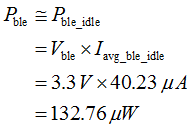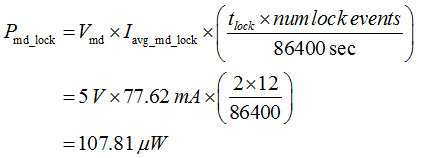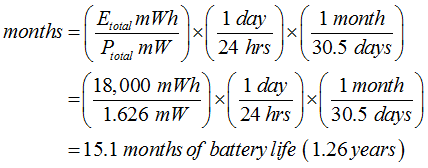TIDUE59A May 2018 – September 2020
- Description
- Resources
- Features
- Applications
- 1System Description
-
2System Overview
- 2.1 Block Diagram
- 2.2 Design Considerations
- 2.3 Highlighted Products
- 2.4 System Design Theory
- 3Hardware, Software, Testing Requirements, and Test Results
- 4Design Files
- 5Software Files
- 6Related Documentation
- 7Terminology
- 8About the Author
- 9Revision History
3.2.5 Battery Life Estimate
The experimental results from Section 3.2.4 can be used to estimate the battery life of a system that is based on this design. Based on the results in Section 3.2.4 and using the assumption that the electronic smart lock is locked or unlocked 24 times per day, users can estimate the power consumed by each subsystem.
The main parameters of the Wi-Fi subsystem that affect the estimated battery life are as follows:
- CC3220 supply voltage: 3.3 V
- Idle connected current: 377 µA
- Average current during a lock or unlock event: 12.12 mA
- Duration of a lock event: 2 seconds
- Average current when reading lock status: 11.82 mA
- Duration of a lock status event: 1.6 seconds
Equation 1 gives the average Wi-Fi idle power.

Equation 2 gives the average Wi-Fi power per day, due to locking and unlocking.

Equation 3 gives the average Wi-Fi power per day, due to the checking lock status.

Equation 4 gives the approximate average Wi-Fi power.

The main parameters of the BLE subsystem that affect the estimated battery life are as follows:
- CC2640R2F supply voltage: 3.3 V
- Average current of the CC2640R2F after provisioning: 40.23 µA
Equation 5 gives the approximate average BLE power.

The main parameters of the motor driver subsystem that affect the estimated battery life are as follows:
- DRV8837 motor supply voltage: 5 V
- Average DRV8837 sleep current: 0.099 µA
- Average current while locking deadbolt: 77.62 mA
- Average current while unlocking deadbolt: 73.15 mA
- Average time spent driving the motor: 2 seconds
Equation 6 gives the average motor driver idle power.

Equation 7 gives the average motor driver power during a lock event.

Equation 8 gives the average motor driver power during an unlock event.

Equation 9 gives the approximate average motor driver power.

Using the calculations for the power consumed by the Wi-Fi, BLE, and motor subsystems, users can estimate the total average system power (see Equation 10).

The estimated total system power can be used to estimate the battery life of the system, using the theoretical energy capacity of the power source. For this estimate, assume an energy capacity of 18,000 mWh and calculate the months of battery life using Equation 11.
